
Sorrel, also called common sorrel or garden sorrel, is a perennial herbaceous plant in the family Polygonaceae. Other names for sorrel include spinach dock and narrow-leaved dock.

Vicia sativa, known as the common vetch, garden vetch, tare or simply vetch, is a nitrogen-fixing leguminous plant in the family Fabaceae. It is now naturalised throughout the world occurring on every continent, except Antarctica and the Arctic. The centre of diversity is thought to be the Fertile Crescent, although gold standard molecular confirmation is currently not available.

Digitalis purpurea, the foxglove or common foxglove, is a toxic species of flowering plant in the plantain family Plantaginaceae, native to and widespread throughout most of temperate Europe. It has also naturalized in parts of North America, as well as some other temperate regions. The plant is a popular garden subject, with many cultivars available. It is the original source of the heart medicine digoxin. This biennial plant grows as a rosette of leaves in the first year after sowing, before flowering and then dying in the second year. It generally produces enough seeds so that new plants will continue to grow in a garden setting.
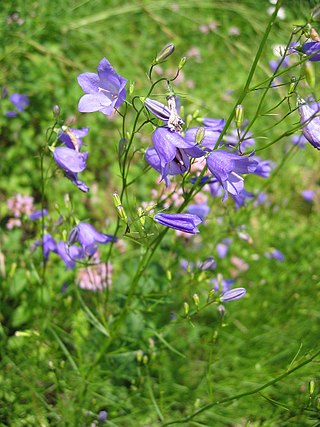
Campanula rotundifolia, the common harebell, Scottish bluebell, or bluebell of Scotland, is a species of flowering plant in the bellflower family Campanulaceae. This herbaceous perennial is found throughout the temperate regions of the northern hemisphere. In Scotland, it is often known simply as bluebell. It is the floral emblem of Sweden where it is known as small bluebell. It produces its violet-blue, bell-shaped flowers in late summer and autumn.

A botanical name is a formal scientific name conforming to the International Code of Nomenclature for algae, fungi, and plants (ICN) and, if it concerns a plant cultigen, the additional cultivar or Group epithets must conform to the International Code of Nomenclature for Cultivated Plants (ICNCP). The code of nomenclature covers "all organisms traditionally treated as algae, fungi, or plants, whether fossil or non-fossil, including blue-green algae (Cyanobacteria), chytrids, oomycetes, slime moulds and photosynthetic protists with their taxonomically related non-photosynthetic groups ."

Eriophorum angustifolium, commonly known as common cottongrass or common cottonsedge, is a species of flowering plant in the sedge family, Cyperaceae. Native to North America, North Asia, and Europe, it grows on peat or acidic soils, in open wetland, heath or moorland. It begins to flower in April or May and, after fertilisation in early summer, the small, unremarkable brown and green flowers develop distinctive white bristle-like seed-heads that resemble tufts of cotton; combined with its ecological suitability to bog, these characteristics give rise to the plant's alternative name, bog cotton.
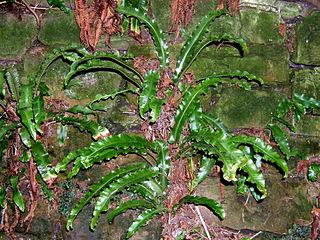
Asplenium scolopendrium, commonly known as the hart's-tongue fern, is an evergreen fern in the family Aspleniaceae native to the Northern Hemisphere.

Molinia caerulea, known by the common name purple moor-grass, is a species of grass that is native to Europe, west Asia, and north Africa. It grows in locations from the lowlands up to 2,300 m (7,546 ft) in the Alps. Like most grasses, it grows best in acid soils, ideally pH values of between 3.5 and 5, however, it can continue to live under more extreme conditions, sometimes to as low as 2. It is common on moist heathland, bogs and moorland throughout Great Britain and Ireland. Introduced populations exist in northeastern and northwestern North America.
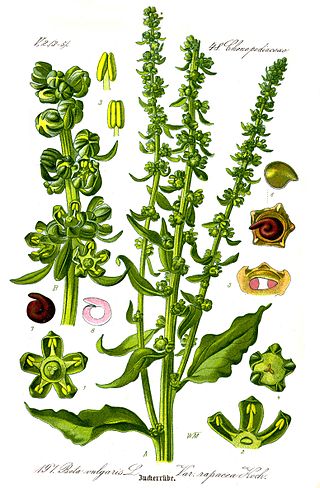
Beta is a genus in the flowering plant family Amaranthaceae. The best known member is the common beet, Beta vulgaris, but several other species are recognised. Almost all have common names containing the word "beet". Wild Beta species can be found throughout the Atlantic coast of Europe, the Mediterranean coastline, the Near East, and parts of Asia including India.

Armeria maritima, the thrift, sea thrift or sea pink, is a species of flowering plant in the family Plumbaginaceae. It is a compact evergreen perennial which grows in low clumps and sends up long stems that support globes of bright pink flowers. In some cases purple, white or red flowers also occur. It is a popular garden flower and has been distributed worldwide as a garden and cut flower. It does well in gardens designed as xeriscapes or rock gardens. The Latin specific epithet maritima means pertaining to the sea or coastal.

Noar Hill is a 63-hectare (160-acre) biological Site of Special Scientific Interest south of Selborne in Hampshire. It is a Nature Conservation Review site, Grade 2, and part of East Hampshire Hangers Special Area of Conservation. An area of 20 hectares is a nature reserve managed by the Hampshire and Isle of Wight Wildlife Trust.

Dactylis glomerata is a species of flowering plant in the grass family Poaceae, known as cock's-foot, also colloquially as orchard grass, or cat grass (due to its popularity for use with domestic cats). It is a cool-season perennial C3 tufted grass native throughout most of Europe, temperate Asia, and northern Africa.
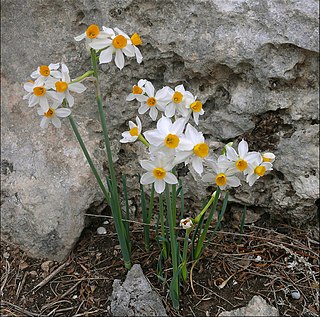
Narcissus tazetta is a perennial ornamental plant that grows from a bulb. Cultivars of N. tazetta include 'Caniculatus', 'Grand Soleil d'Or' and 'Ziva', which are popularly used for forcing indoors, as is the form of N. tazetta known as Chinese Sacred Lily.

Arrhenatherum elatius is a species of flowering plant in the grass family Poaceae, commonly known as false oat-grass, and also bulbous oat grass, tall oat-grass, tall meadow oat, onion couch and tuber oat-grass. It is native throughout Europe, and also western and southwestern Asia, and northwestern Africa. This tufted grass is sometimes used as an ornamental grass and is sometimes marketed as "cat grass".
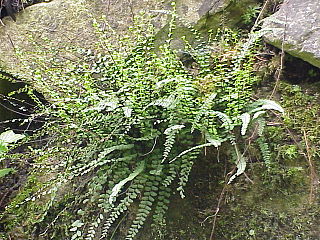
Asplenium trichomanes, the maidenhair spleenwort, is a small fern in the spleenwort genus Asplenium. It is a widespread and common species, occurring almost worldwide in a variety of rocky habitats. It is a variable fern with several subspecies.

Oenanthe pimpinelloides is a species of flowering plant in the family Apiaceae known by the common name corky-fruited water-dropwort. It is a plant of tall, lightly grazed or infrequently mown grassland and coastal meadows in Europe and neighbouring parts of Asia and North Africa.
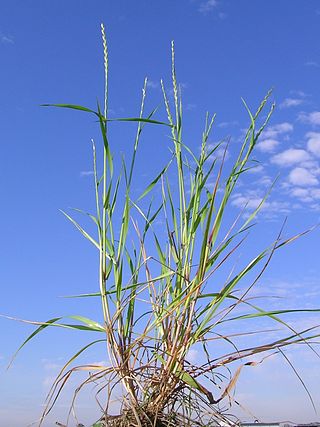
Lolium rigidum is a species of annual grass. Common names by which it is known include annual ryegrass, a name also given to Italian ryegrass, rigid ryegrass, stiff darnel, Swiss ryegrass and Wimmera ryegrass. It is a native of southern Europe, northern Africa, the Middle East and the Indian subcontinent and is grown as a forage crop, particularly in Australia, where it is also a serious and economically damaging crop weed.
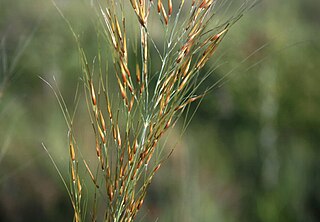
Loudetia simplex is a grass species found in tropical and Southern Africa and Madagascar. It was originally described as a Tristachya species by Christian Gottfried Daniel Nees von Esenbeck in 1841 and was transferred to Loudetia by Charles Edward Hubbard in 1934.

Catapodium marinum, the sea fern grass, is a species of annual herb in the family Poaceae. They have a self-supporting growth form and simple, broad leaves. Individuals can grow to 22 cm tall.

Parapholis strigosa, commonly known as slender barb grass, sea hard grass, and hard grass, is a species of grass. It is native to Europe and Libya and is an introduced species to parts of the Americas and Oceania.






















